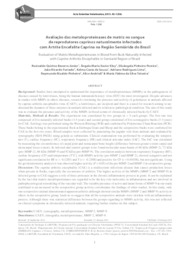Avaliação das metaloproteinases de matriz no sangue de reprodutores caprinos naturalmente infectados com Artrite Encefalite Caprina na Região Semiárida do Brasil.
Avaliação das metaloproteinases de matriz no sangue de reprodutores caprinos naturalmente infectados com Artrite Encefalite Caprina na Região Semiárida do Brasil.
Author(s): BEZERRA JUNIOR, R. Q.; ELOY, A. M. X.; PEREIRA, E. P.; FURTADO, J. R.; SOUZA, K. C. de; LIMA, A. R.; PINHEIRO, R. R.; ANDRIOLI, A.; TEIXEIRA, M. F. da S.
Summary: [Evaluation of Matrix Metalloproteinases in Blood from Buck Naturally Infected with Caprine Arthritis Encephalitis in Semiarid Region of Brazil]. Background: Studies have attempted to understand the importance of metalloproteinase (MMPs) in the pathogenesis of diseases caused by lentiviruses, being the human immunodeficiency virus (HIV) the most investigated. Despite advances in studies with MMPs in others diseases, research correlating the presence and activity of gelatinases in animals affected by caprine arthritis encephalitis virus (CAEV), a lentiviruses, are incipient and there is a need for research aiming to understand the dynamic of these enzymes in animals infected and its relation to pathological condition. The aim of this study was to evaluate the presence and activity of the MMPs in blood serum of chronically infected bucks by CAEV. Materials, Methods & Results: The experiment was constituted by two groups (n = 5 each group). The first one was composed of five naturally infected bucks (4-5 years) and second group constituted of five seronegative bucks (3-4 years) for CAE. Serology was performed using the Western Blotting (WB) and confirmed by Polymerase Chain Reaction (PCR). These bucks belong to the experimental flock at Embrapa Goats and Sheep and the seropositive bucks were confirmed for CAE in the first two years. Blood samples were collected by puncturing the jugular vein from animals and evaluated by zymography (SDS-PAGE) using gelatin as substratum. Clinical examination was performed by evaluating the temperature (T), cardiac frequency (FC), respiratory frequency (FR) and clinical articular index (IAC). The IAC was calculated by measuring the circumference of carpal joint and metacarpal bone height (difference between greater extent carpal and metacarpal lesser extent). In infected and control groups were found molecular mass bands of 66 kDa (MMP-2), 72 kDa (pro-MMP-2), 86 kDa (MMP-9) and 92 kDa (pro-MMP-9). The correlation analysis between respiratory frequency (RF), cardiac frequency (CF) and temperature (T°C), with MMPs activity (pro-MMP-2 and MMP-2), showed a negative and not significant correlation for RF (r = -0.1285) and T (r = -0.2588) and positive for CF (r = 0.01038), but not significant. Using the gel densitometry analysis it was observed higher activity (P < 0.05) of the pro-MMP-2 and MMP-2 in seropositive group. Discussion: The caprine arthritis encephalitis (CAE) is a multisystem infectious disease that causes production losses when present in flocks, especially the occurrence of arthritis. The higher activity of the MMPs (MMP-2 and MMP-9) in infected group to CAE suggests a role of these proteases in the chronic inflammatory process in goats. It can be explained by the fact that matrix metalloproteinases are regarded to be the key role molecules in inflammation and are involved in pathophysiological remodeling of the vascular wall. The variable presence of active and latent forms of MMP-9 in our study combined to an increased in the seropositive group activity corroborates the findings of other studies. In this study, only one seropositive animal demonstrated apparent arthritis although showed similar MMPs (MMP-2 and MMP-9) activity to others in the seropositive group, leads us to suggest that all the seropositive animals were stricken with an inflammatory process. Although there was statistical difference between the groups regarding to MMPs activity, this was not reflected on clinical symptoms in chronically infecetd animals, requiring further studies on this subject.
Publication year: 2015
Types of publication: Journal article
Unit: Embrapa Goats & Sheep
Observation
Some of Embrapa's publications are published as ePub files. To read them, use or download one of the following free software options to your computer or mobile device. Android: Google Play Books; IOS: iBooks; Windows and Linux: Calibre.
Access other publications
Access the Agricultural Research Database (BDPA) to consult Embrapa's full library collection and records.
Visit Embrapa Bookstore to purchase books and other publications sold by Embrapa.

